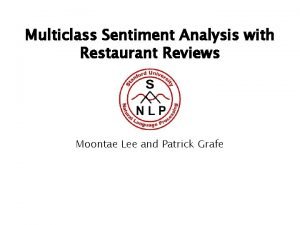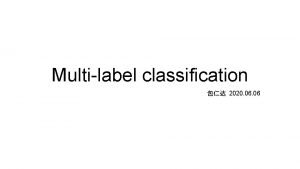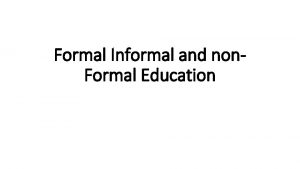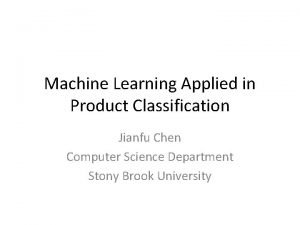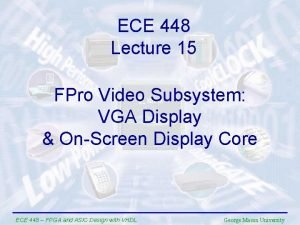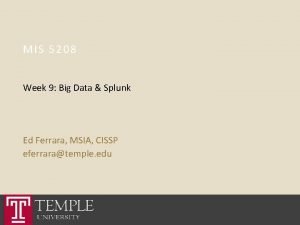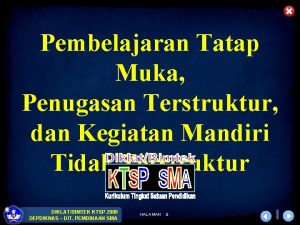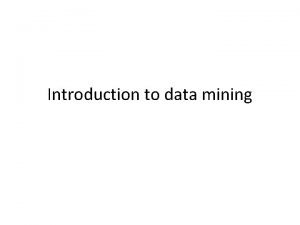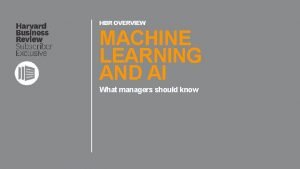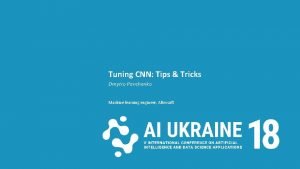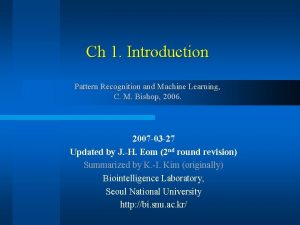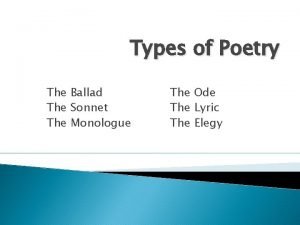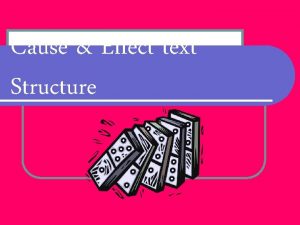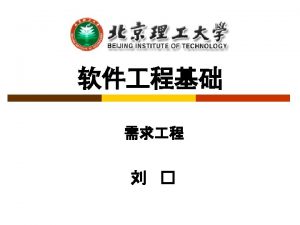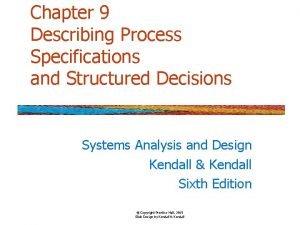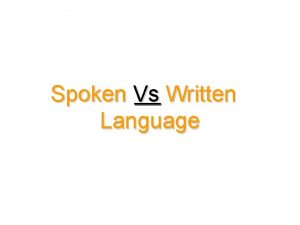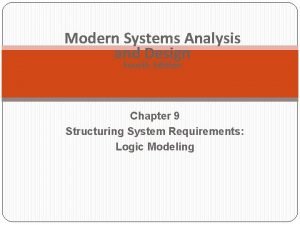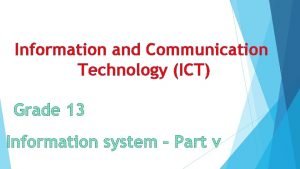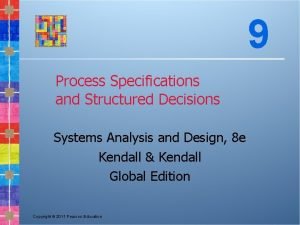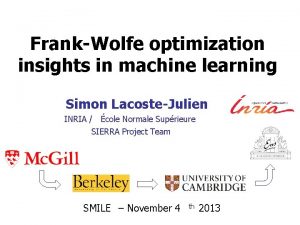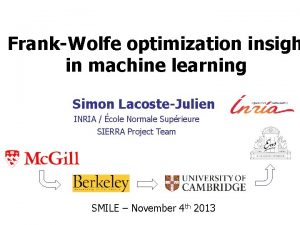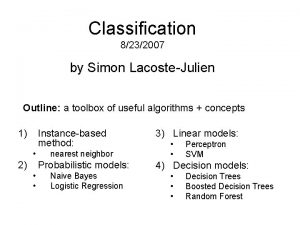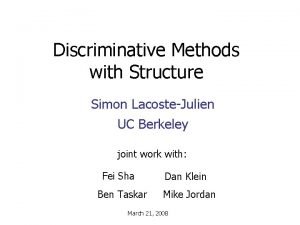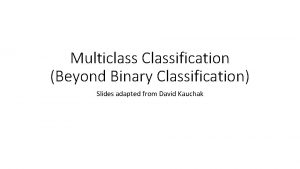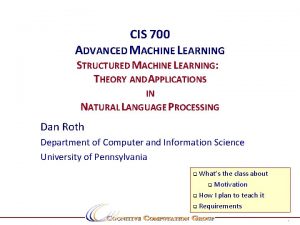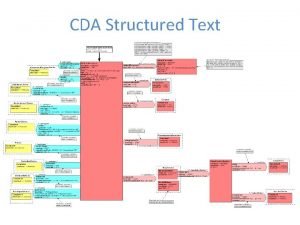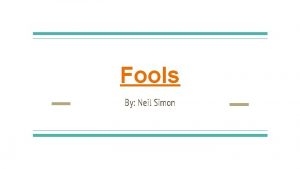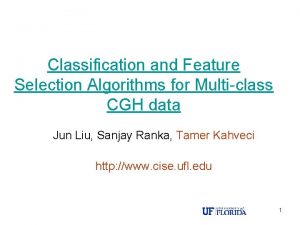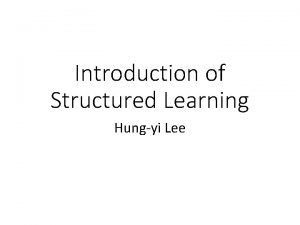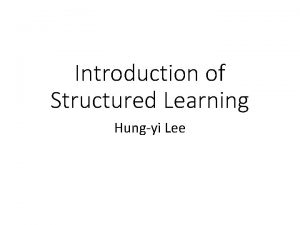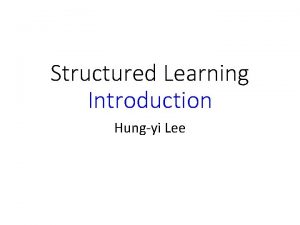MultiClass and Structured Classification Simon LacosteJulien Machine Learning

























![Local Classification building tree shrub ground [thanks to Ben Taskar for slide!] Local Classification building tree shrub ground [thanks to Ben Taskar for slide!]](https://slidetodoc.com/presentation_image_h/f7fdb10bcad185f3adc05951e8aae156/image-26.jpg)

![Structured Classification building tree shrub ground [thanks to Ben Taskar for slide!] Structured Classification building tree shrub ground [thanks to Ben Taskar for slide!]](https://slidetodoc.com/presentation_image_h/f7fdb10bcad185f3adc05951e8aae156/image-28.jpg)
















![[thanks to Ben Taskar for slide!] Object Segmentation Results Data: [Stanford Quad by Segbot] [thanks to Ben Taskar for slide!] Object Segmentation Results Data: [Stanford Quad by Segbot]](https://slidetodoc.com/presentation_image_h/f7fdb10bcad185f3adc05951e8aae156/image-45.jpg)
- Slides: 45

Multi-Class and Structured Classification Simon Lacoste-Julien Machine Learning Workshop Friday 8/24/07 [built from slides from Guillaume Obozinksi]

Basic Classification in ML Input Spam filtering Character recognition [thanks to Ben Taskar for slide!] Output Binary !!!!$$$!!!! Multi-Class C

Structured Classification Input Handwriting recognition 3 D object recognition [thanks to Ben Taskar for slide!] Output Structured output brace building tree

Multi-Classification • Multi-classification : direct approaches – Nearest Neighbor – Generative approach & Naïve Bayes – Linear classification: • • geometry Perceptron K-class (polychotomous) logistic regression K-class SVM • Multi-classification through binary classification – – One-vs-All All-vs-all Others Calibration

Different structures Multi-label classification • Is it eatable? Is it a banana? • Is it sweet? Is it an apple? Is it yellow? • Is it a fruit? Is it an orange? Is it sweet? • Is it a banana? Is it a pineapple? Is it round? Nested/ Hierarchical Exclusive/ Multi-class General/Structured

Nearest Neighbor, Decision Trees - From the classification lecture: • NN and k-NN were already phrased in a multi-class framework • For decision tree, want purity of leaves depending on the proportion of each class (want one class to be clearly dominant)

Generative models As in the binary case: 1. Learn p(y) and p(y|x) 2. Use Bayes rule: 3. Classify as p(y) p(x|y) p(y|x)

Generative models • Advantages: • Fast to train: only the data from class k is needed to learn the kth model (reduction by a factor k compared with other method) • Works well with little data provided the model is reasonable • Drawbacks: • Depends on the quality of the model • Doesn’t model p(y|x) directly • With a lot of datapoints doesn’t perform as well as discriminative methods

Naïve Bayes Class Assumption: Given the class the features are independent Y X 1 X 2 X 3 X 4 X 5 Features If the features are discrete: Bag-of-words models

Linear classification • Each class has a parameter vector (wk, bk) • x is assigned to class k iff • Note that we can break the symmetry and choose (w 1, b 1)=0 • For simplicity set bk=0 (add a dimension and include it in wk) • So learning goal given separable data: choose wk s. t.

Three discriminative algorithms

Geometry of Linear classification Perceptron K-class logistic regression K-class SVM

Multiclass Perceptron Online: for each datapoint Update: Predict: • Advantages : • Extremely simple updates (no gradient to calculate) • No need to have all the data in memory (some point stay classified correctly after a while) • Drawbacks • If the data is not separable decrease a slowly…

Polychotomous logistic regression distribution in exponential form Online: for each datapoint Batch: all descent methods Especially in large dimension, use regularization Advantages: • Smooth function • Get probability estimates Drawbacks: • Non sparse small flip label probability (0, 0, 1) (. 1, . 8)

Multi-class SVM Intuitive formulation: without regularization / for the separable case Primal problem: QP Solved in the dual formulation, also Quadratic Program Main advantage: Sparsity (but not systematic) Drawbacks: • Speed with SMO (heuristic use of sparsity) • Need to recalculate or store xi. Txj • Sparse solutions • Outputs not probabilities

Real world classification problems Automated protein classification Object recognition 10 Phoneme recognition 300 -600 100 http: //www. glue. umd. edu/~zhelin/recog. html Digit recognition • The number of classes is sometimes big 50 [Waibel, Hanzawa, Hinton, Shikano, Lang 1989] • The multi-class algorithm can be heavy

Combining binary classifiers One-vs-all For each class build a classifier for that class vs the rest • Often very imbalanced classifiers (use asymmetric regularization) All-vs-all For each class build a classifier for that class vs the rest • A priori a large number of classifiers to build but… • The pairwise classification are way much faster • The classifications are balanced (easier to find the best regularization) … so that in many cases it is clearly faster than one-vs-all

Confusion Matrix Predicted classes difficult to learn • Can also be used to compare two different classifiers • Cluster classes and go hierachical [Godbole, ‘ 02] Actual classes • Visualize which classes are more Classification of 20 news groups [Godbole, ‘ 02] BLAST classification of proteins in 850 superfamilies

Calibration How to measure the confidence in a class prediction? Crucial for: 1. Comparison between different classifiers 2. Ranking the prediction for ROC/Precision-Recall curve 3. In several application domains having a measure of confidence for each individual answer is very important (e. g. tumor detection) Some methods have an implicit notion of confidence e. g. for SVM the distance to the class boundary relative to the size of the margin other like logistic regression have an explicit one.

Calibration Definition: the decision function f of a classifier is said to be calibrated or well-calibrated if Informally f is a good estimate of the probability of classifying correctly a new datapoint x which would have output value x. Intuitively if the “raw” output of a classifier is g you can calibrate it by estimating the probability of x being well classified given that g(x)=y for all y values possible.

Calibration Example: a logistic regression, or more generally calculating a Bayes posterior should yield a reasonably well -calibrated decision function.

Combining OVA calibrated classifiers + + ++ + ++ ++ Class 4 + ++ + + + ++ ++ + Class 3 + ++ + ++ ++ Class 2 Calibration Class 1 p 2 p 3 p 4 Renormalize pother consistent (p 1, p 2, …, p 4, pother)

Other methods for calibration • Simple calibration • Logistic regression • Intraclass density estimation + Naïve Bayes • Isotonic regression • More sophisticated calibrations • Calibration for A-vs-A by Hastie and Tibshirani

Structured classification

Local Classification brar e Classify using local information Ignores correlations! [thanks to Ben Taskar for slide!]
![Local Classification building tree shrub ground thanks to Ben Taskar for slide Local Classification building tree shrub ground [thanks to Ben Taskar for slide!]](https://slidetodoc.com/presentation_image_h/f7fdb10bcad185f3adc05951e8aae156/image-26.jpg)
Local Classification building tree shrub ground [thanks to Ben Taskar for slide!]

Structured Classification brace • Use local information • Exploit correlations [thanks to Ben Taskar for slide!]
![Structured Classification building tree shrub ground thanks to Ben Taskar for slide Structured Classification building tree shrub ground [thanks to Ben Taskar for slide!]](https://slidetodoc.com/presentation_image_h/f7fdb10bcad185f3adc05951e8aae156/image-28.jpg)
Structured Classification building tree shrub ground [thanks to Ben Taskar for slide!]

Structured Classification • Structured classification : direct approaches – Generative approach: Markov Random Fields (Bayesian modeling with graphical models) – Linear classification: • Structured Perceptron • Conditional Random Fields (counterpart of logistic regression) • Large-margin structured classification

Structured classification Simple example HMM: “Label sequence” “Observation sequence” b r a c e Optical Character Recognition

Structured Model • Main idea: define scoring function which decomposes as sum of features scores k on “parts” p: • Label examples by looking for max score: • Parts = nodes, edges, etc. space of feasible outputs

Tree model 1 “Label structure” “Observations”

Tree model 1 Eye color inheritance: haplotype inference

Tree Model 2: Hierarchical Text Classification Root Arts Cannes Film Festival schedule. . . . . X: webpage Movies Television Y: label in tree Business Computers Internet Software Jobs Real Estate (from ODP)

Grid model Image segmentation Segmented = “Labeled” image

Decoding and Learning Three important operations on a general structured (e. g. graphical) model: • Decoding: find the right label sequence • Inference: compute probabilities of labels • Learning: find model + parameters w so that decoding works HMM example: b r a c e • Decoding: Viterbi algorithm • Inference: forward-backward algorithm • Learning: e. g. transition and emission counts of learning a generative model from fully labeled training data) (case

Decoding and Learning • Decoding: algorithm on the graph (eg. max-product) Use dynamic programming to take • Inference: algorithm on the graph advantage of the (eg. sum-product, belief propagation, junction tree, sampling) structure • Learning: inference + optimization 1. Focus of graphical model class 2. Need 2 essential concepts: 1. cliques: variables that directly depend on one another 2. features (of the cliques): some functions of the cliques

Cliques and Features b r a c e In undirected graphs: cliques = groups of completely interconnected variables In directed graphs: cliques = variable+its parents

Exponential form Once the graph is defined the model can be written in exponential form parameter vector feature vector Comparing two labellings with the likelihood ratio

Our favorite (discriminative) algorithms The devil is the

(Averaged) Perceptron For each datapoint Predict: Update: Averaged perceptron:

Example: multiclass setting Feature encoding: Predict: Update:

CRF Z difficult to compute with complicated graphs Conditioned on all the observations Introduction by Hannah M. Wallach http: //www. inference. phy. cam. ac. uk/hmw 26/crf/ MEMM & CRF, Mayssam Sayyadian, Rob Mc. Cann anhai. cs. uiuc. edu/courses/498 ad-fall 04/local/my-slides/crf-students. pdf 3 M net No Z … The margin penalty can “factorize” according to the problem structure Introduction by Simon Lacoste-Julien http: //www. cs. berkeley. edu/~slacoste/school/cs 281 a/project_report. html

![thanks to Ben Taskar for slide Object Segmentation Results Data Stanford Quad by Segbot [thanks to Ben Taskar for slide!] Object Segmentation Results Data: [Stanford Quad by Segbot]](https://slidetodoc.com/presentation_image_h/f7fdb10bcad185f3adc05951e8aae156/image-45.jpg)
[thanks to Ben Taskar for slide!] Object Segmentation Results Data: [Stanford Quad by Segbot] Trained on 30, 000 point scene Tested on 3, 000 point scenes Evaluated on 180, 000 point scene Model Error Local learning 32% Local prediction Local learning +smoothing Structured method 27% [Taskar+al 04, Anguelov+Taskar+al 05] 7% Laser Range Finder Segbot M. Montemerlo S. Thrun building tree shrub ground
 Moontae lee
Moontae lee Multilabel vs multiclass
Multilabel vs multiclass Jackson structured development
Jackson structured development Disadvantages of unstructured interviews
Disadvantages of unstructured interviews Inductive and analytical learning
Inductive and analytical learning Inductive and analytical learning problem
Inductive and analytical learning problem Eager learner and lazy learner
Eager learner and lazy learner Merits of non formal education
Merits of non formal education Product classification machine learning
Product classification machine learning Classification machine learning
Classification machine learning Concept learning task in machine learning
Concept learning task in machine learning Analytical learning in machine learning
Analytical learning in machine learning Pac learning model in machine learning
Pac learning model in machine learning Pac learning model in machine learning
Pac learning model in machine learning Instance based learning in machine learning
Instance based learning in machine learning Inductive learning machine learning
Inductive learning machine learning First order rule learning in machine learning
First order rule learning in machine learning Cmu machine learning
Cmu machine learning Structured support vector machine
Structured support vector machine What is big data mis
What is big data mis Cuadro comparativo de e-learning b-learning y m-learning
Cuadro comparativo de e-learning b-learning y m-learning Kegiatan mandiri tidak terstruktur
Kegiatan mandiri tidak terstruktur Moore and mealy machine
Moore and mealy machine Chapter 10 energy, work and simple machines answer key
Chapter 10 energy, work and simple machines answer key Machine learning and data mining
Machine learning and data mining Andrew ng hbr
Andrew ng hbr Dmytro panchenko
Dmytro panchenko Introduction to azure ml
Introduction to azure ml Cm bishop pattern recognition and machine learning
Cm bishop pattern recognition and machine learning Finite state machine vending machine example
Finite state machine vending machine example Moore machine
Moore machine Classification and tabulation
Classification and tabulation Tony wagner's seven survival skills
Tony wagner's seven survival skills It is a dignified and elaborately structured lyric poem
It is a dignified and elaborately structured lyric poem Define structured analysis
Define structured analysis Structured system analysis and design method
Structured system analysis and design method Contoh kuesioner tidak terstruktur
Contoh kuesioner tidak terstruktur Structured guidance and supports
Structured guidance and supports L
L Basic building blocks of warnier orr diagram is/are
Basic building blocks of warnier orr diagram is/are Structured systems analysis and design method
Structured systems analysis and design method Describe the process specification structured decisions.
Describe the process specification structured decisions. Spoken vs written
Spoken vs written Structured english in system analysis and design
Structured english in system analysis and design Ssadm
Ssadm Structured decision in system analysis and design
Structured decision in system analysis and design
